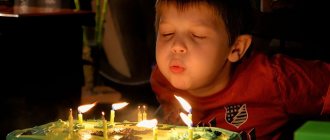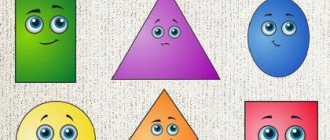The well-known children's writer (author of such fairy tales as “Telephone”, “Stolen Sun”, etc.) Korney Ivanovich Chukovsky has a book called “From Two to Five”, where he collected funny sayings of children. “Dad, look how your pants are frowning!”
The author explained that a child of three to five years old comes up with words that are understandable to others, but are not correct from the point of view of the Russian language. A four-year-old child can easily replace the word “band-aid” with “adhesive plaster” - a child’s vision of the world.
The child is 4 years old, he considers himself independent and is actively interested in everything that happens, asking a bunch of questions, both basic and quite difficult even for parents. It's time to buy encyclopedias!
Questions rain down on parents’ heads as if from a cornucopia. You can hear the most unexpected questions from a four-year-old child, ranging from the structure of his toys to the structure of the universe. Naturally, mothers, fathers, grandparents need enormous patience and endurance so as not to brush aside annoying questions that sometimes baffle.
The baby can almost dress himself (except for tying shoelaces and fastening complex hooks and eyelets), runs and jumps deftly, and communicates with other children and adults. In a word, a four-year-old child is an adult in miniature, only very curious and funny.
Features of speech of four-year-old children
The level of speech development during this age period greatly depends on the level of family upbringing and on the quality of education children receive in a preschool institution. This difference becomes more noticeable the closer he gets to the five-year mark.
If in kindergarten he was lucky enough to get a sensitive teacher who understands the importance of the speech development of preschoolers, we can assume that by the beginning of school he will come with a solid baggage of developed and figurative speech, and with reading and writing in the first grade he will not have much. problems.
In families where they brush aside the child’s attempts to communicate or ask about what interests him, where there is not a single children’s book in the house, and all the responsibilities dedicated to the development of children, mom and dad transferred to the kindergarten, nannies and their parents, beautiful and Correct speech in a child at the beginning of school is very rare.
Lexicon
From four to five years, a child’s vocabulary increases from two and a half to three thousand words. Such a wealth of vocabulary gives him the opportunity to accurately name objects and their qualities (strong, cheerful, strong, thin, tall, long, small). Children with the ability to create words actively come up with their own words. Each parent can, if desired, recall more than one example of such words invented by their children at this age.
Vsekhniy is general, melkoscope is a microscope, oggnata are sparks of fire - these examples of word creation are given in his book “From Two to Five” by the researcher of children’s speech, writer K.I. Chukovsky. In addition to actively learning new words, children enjoy playing with rhymes, inventing their own poems. These poems may consist of strange combinations of sounds that are not similar to any word we know (“And I came up with a word, the funny word “plyam”). You should not condemn a child for such a meaningless activity, from the point of view of adults. Little poets train their ear for speech in this way, learning to select words that sound similar in sound.
The normal speech development of children aged 4–5 years leads to the fact that more and more adjectives appear in the dictionary, since clarification of the qualities and characteristics of objects is now in the foreground in speech. The color of the item is now not only blue and red, it can be pink, lilac, dark and light, blue and orange.
In the speech of a four-year-old child there are more prepositions, they become more complex (because of, from under). The number of personal pronouns is increasing, they are increasingly used as predicates (I, we, you, you). Occasionally you can hear collective nouns, which he now uses to the place (vegetables, fruits, dishes, furniture).
Grammar of children's speech
At this age, children are already able to construct a logically correctly formed statement from several phrases. Sentences can be not only simple, but also complex. (We'll put on boots because it's cold. They bought me candy and my brother some cookies).
The rapid development of speech, the desire to speak out, a sharp jump in the number of words mastered leads to the fact that errors are often encountered in speech:
- the structure of sentences is disrupted;
- There is an incorrect agreement on gender and number (two chairs, blue tights);
- verbs change incorrectly (we want, they laugh).
Despite the shortcomings encountered, in most cases children correctly formulate their statements and begin to master monologue speech. Not immediately, with the help of an adult, children master retelling a short text, read story or fairy tale. Four-year-olds notice mistakes in the speech of their peers, but hardly notice their own shortcomings.
Sound pronunciation
The child grows, and along with the rest of the muscles, the muscles of the articulation organs, especially the lips and tongue, become stronger and more coordinated. It becomes noticeable that children correctly pronounce most polysyllabic words, without rearranging syllables, place stress correctly, and their speech is close to the literary norms of their native language. If work on the development of speech hearing was previously carried out in a family or in a kindergarten, now children can already recognize sounds by ear and come up with words for a given sound.
At the age of four, many children have mastered the pronunciation of all sounds; they pronounce them clearly and clearly. Some articulation deficiencies that occur at this age are considered the age norm and can disappear over time without correction and special classes:
- the use of hissing and whistling sounds can be unstable, correct in some words and incorrect in others (fur coat - skola, toad - zuk, cheeks - mesh);
- the sounds l and r, although correctly pronounced in isolated form, are not always pronounced correctly in words; children replace them with other sounds (yoshad - horse, movoko - milk, yuki - hands, Malina - Marina);
- indistinctly pronounces unfamiliar words.
The help of a speech therapist is required in cases of obvious lisp (interdental [s] and [z]) and a graduated pronunciation of the sound [r], when it is not the tip of the tongue that vibrates, but the soft palate or a small tongue in the pharynx (“French pronunciation”, “burr”). Once such defective pronunciation takes hold, it will be very difficult to correct it later. Correcting the grazing sound [r] may take from a year to a year and a half. If there are doubts about whether the child pronounces this sound correctly, you need to ask him to pronounce it with his mouth open. If the sound [r] is defective, this cannot be done.
Working out at home
In difficult cases, sessions with a speech therapist alone will not be enough. Parents will have to work with the child on their own. However, even with a more favorable prognosis, home exercises will only bring benefits. This includes consolidating the skills learned from a speech therapist, and completely at-home games if, for example, it was not possible to find a suitable speech therapist or the problem is not too serious.
Here are a few rules that will help parents properly organize speech therapy classes for children at home.
- Turn every activity into a game. If a child is interested, he learns the necessary skills unobtrusively and quickly.
- Increase the duration of classes gradually: starting from 5 minutes, gradually increasing to 20–35.
- Don't overload your child with information. 2-3 games at a time are quite enough for adequate assimilation of the material.
- Remember to praise. This is the best incentive for a baby.
- Play when the child is alert and in a good mood (after breakfast or lunchtime nap).
- Remember that your baby learns everything by imitating you. Therefore, always show him something by turning him face to face.
- If, when completing a task, you introduce your child to some natural phenomena, structure the work so that they relate to reality (we study snow and frost in winter, leaf fall in autumn).
Buy special literature to help you organize and conduct classes. For example, benefits N.E. Teremkova, T.Yu. Bardysheva, E.N. Monosova. These authors have various benefits for any age.
The norm of speech development of children of the fifth year of life
The state of children's speech at the age of four to five years can be very different: from perfect command of the capabilities of their native language to very slurred statements with a meager vocabulary and a lot of grammatical errors.
Guidelines that you can rely on when analyzing the state of children’s speech:
- a child of five years of age uses words exactly according to their meaning;
- in addition to the main parts of speech, he actively uses adjectives, adverbs, and pronouns;
- children can quite fully describe toys, objects, pictures;
- most sounds are pronounced clearly and correctly, although the articulation of [l] and [r] may not yet be mastered;
- he is able to control the volume of his speech and can speak in a whisper;
- the pace of statements is average, without slowness or excessive haste;
- When reciting poetry and telling fairy tales, children use expressive intonation.
In the fifth year of life, children can already speak faster and slower, pronounce words quieter and louder, and notice these nuances in the speech of other people. Kids add an interesting emotional color to their statements and use intonation to express their messages. This allows them to recite poems they have learned by heart with greater artistry.
The main quality of children's speech at this age is its coherence and consistency in the presentation of thoughts.
Speech delay
In rare cases, at this age there may be children who not only cannot speak fluently, but also cannot compose a simple sentence of 2-3 words. Non-speaking children by this age should cause concern among parents, since delayed speech development in children 4 years old requires immediate correction and intervention from specialists. Possible reasons for this lag could be:
- problems in the field of neurology;
- intellectual impairment, mental retardation;
- suffered birth trauma, pathology of pregnancy in the mother of the baby;
- problems with motor skills of the organs of articulation (“cleft palate”, cleft soft palate);
- social neglect, lack of communication with adults.
Another type of speech delay that does not always cause concern for parents is the child’s unintelligible speech, especially if, according to the parents, “he understands everything, he just can’t say it.” Children with unintelligible speech are characterized by the following disorders:
- incorrect pronunciation of polysyllabic words (ignusinny - toy, tivilizil - TV), syllables and sounds are rearranged and missing in words;
- cannot answer an adult’s question with a common sentence, his answers are monosyllabic;
- he cannot finish a sentence started by an adult, talk about an object, a toy, a picture;
- the vocabulary is poor, limited to a primitive set of words most often used in everyday life;
- finds it difficult to select the right words, may confuse them if they are similar in sound but different in meaning;
- His articulation lacks the pronunciation of most sound groups: hissing, whistling, frequent substitutions of sounds, he does not notice speech errors in himself and those around him.
Diagnosis of speech disorders
To check on your own how things are going with speech disorders in a child who speaks incomprehensibly, you can conduct several simple tests. To study vocabulary, he is asked to name animals, seasons, dishes, toys, furniture from pictures.
Children are asked to name objects, phenomena, qualities of objects, to carry out an assignment (draw something, bring an object or toy). To find out how they can change words, they offer the following tasks:
- form the plural (nose – noses, chair – chairs),
- offer to count objects, determining how he coordinates nouns with numerals (one book, two books, etc.);
- say “affectionately” (doll - doll, bed - crib).
To determine the level of development of phrasal speech, children are asked to complete a sentence started by an adult: “The boy... is playing ball.” For this, pictures with different scenes are used. When observing a child’s speech in everyday life, you need to note for yourself which parts of speech the child uses and evaluate his ability to correctly construct a phrase.
To examine the syllabic structure of a word, the child is offered verbal tasks without using pictures: repeat syllables from different consonants and vowels (lo-se-ku, pi-ka-chu), syllables from the same consonants and different vowels (da-doo-dy-do) , from the same vowels and different consonants (la-ma-ka-sa). To understand whether the child feels the rhythm of speech, they tap the rhythm of a simple word and ask him to repeat it in the same way.
How are classes going?
First, the specialist gets to know the parents and the baby, establishes contact with the child, and encourages him to communicate. And this is not always easy: some children are too reserved, others are shy or afraid of strangers, others are hyperactive and do not sit still.
Next, the specialist conducts speech therapy diagnostics:
- reveals the child’s ability to perceive information and understand the questions asked (estimates how long the child is looking for an answer);
- assesses vocabulary and gesture capabilities;
- assesses the degree of speech coherence, the number and types of speech errors;
- identifies problems with pronunciation - which groups of sounds are affected, in which parts of words they are pronounced defectively, etc.
Based on the information received, the speech therapist builds an individual plan for working with the child. Most often these are classes 2 times a week lasting from 30 to 45 minutes.
A good speech therapist allows and even welcomes the presence of parents in such classes, always comments on the progress achieved, constantly gives homework to consolidate acquired skills, showing parents what exercises and how to do them at home.
Classes for children 4 years old are conducted in the form of a game and include, if necessary, articulation and breathing exercises, logorhythmic exercises, exercises for producing sounds, the development of fine motor skills, speech breathing and phonemic hearing, and general speech development.
By the age of 5, such classes are no longer carried out only in the form of games - they prepare the child for the fact that he will soon have to sit in lessons at school and complete the teacher’s assignments. Therefore, they also include tasks for the development of intelligence.
Speech therapy games actively use all kinds of manuals (with pictures, coloring books, tasks for tracing a picture along the contour), bright thematic pictures, cards, children's lotto, cubes, pyramids, toys or objects that make sounds, children's musical instruments; weightless paper figurines of birds and butterflies; balls, plasticine, etc.
The most important tool in any speech therapist's arsenal is patience and praise.
At the same time, exercises related to articulation and production of sounds must be practiced in front of a mirror, so that the child can see the movements of the speech therapist, compare them with his own, and can visually control the correct execution.








